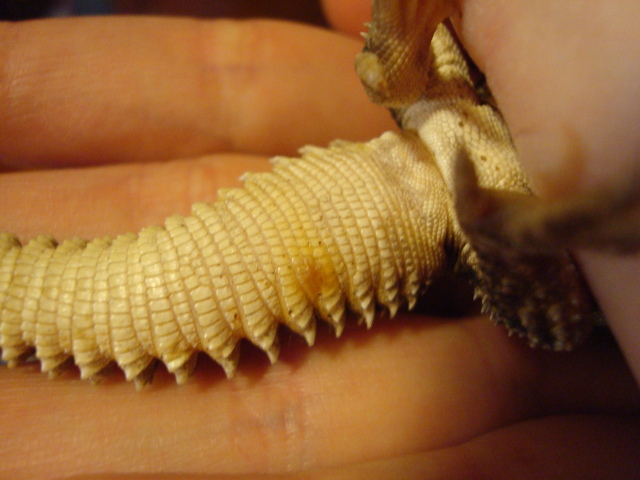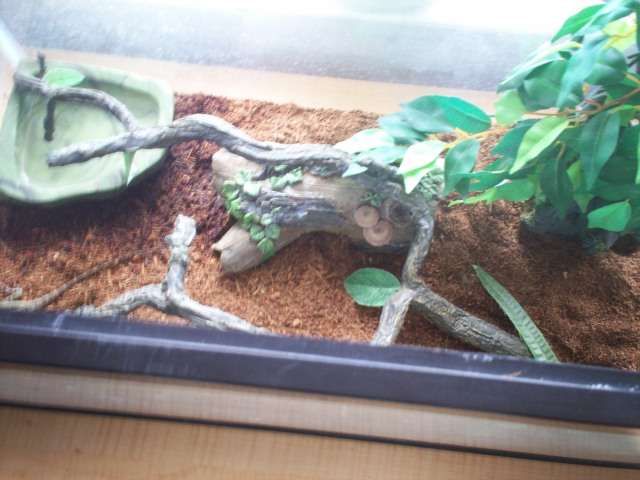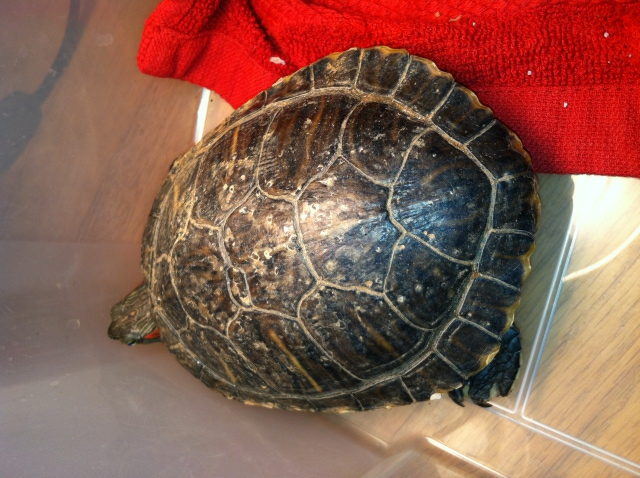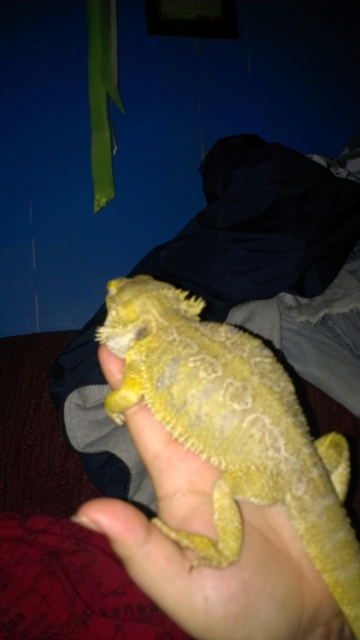QuestionI got a leopard gecko about two weeks ago. When we first got him, we put him in a cage with another male gecko temporarily and we fed them both crickets and our gecko ate one cricket. He hasn't eaten since, and that was two weeks ago. Now he is in his own cage; he has a heated lamp and rocks that provide shade. He likes to climb and is very active, but we have been feeding him crickets every day and he only kills them and doesn't eat them. Now we are trying to feed him wax worms, and he hasn't seemed to recognize them. His tail has gotten a little bit smaller, but it is still pretty fat. Is this normal? Should we take him to the vet or is he still possibly adjusting to his new home? He shed yesterday and today and we think he is done shedding, and the skin that he shed is gone. Thanks so much for your help.
AnswerHi Holly,
Its good he has his own cage now. He should remain in his own cage forever. Males will kill each other...they can never be housed together.
The crickets you are offering may be too large for him. Try smaller sized crickets to see if that helps.
You don't want to get him hooked on waxworms as they are too high in fat content and can cause fatty liver disease. They are ok on occasion, and only a few of them.
Leos store fat in their tails. The tail getting skinny means that he is using stored fat which he needs to start eating to keep that fat storage up.
The trauma of him being in with another male was probably very stressful for him.
I am including a basic care sheet for you. Double check your care...especially temperatures, (under tank heater, etc) as incorrect temperatures are many times a cause of not eating.
If temperatures are correct and that doesn't get him eating in a day or two at the most, then I do suggest a vet visit and have an internal parasite check done as that can also cause them not to eat.
There are links to finding a vet below.
BASIC CARE FOR A LEOPARD GECKO
Leopards are pretty easy to care for but they do need
special care. Here are some of the basic needs of your gecko.
HOUSING: The need to have at least a 20 gallon long tank for one Leo. This needs to have a secure fitting screen top...they can be quite the escape artists!!! They need to have a humid hide box.You can make this with something as simple as a small plastic dish with a hole cut in one side and a small mesh bag filled with some Sphagnum moss coconut bark or Peat moss that you mist.
I made mine out of the small plastic folgers coffee containers...I cut an opening in the lid..and put the moss in..they LOVE it. I use the terrarium moss in mine.
I use that on the warm side of the tank. Be sure to provide a cool hidebox on the other end. I also provide a mid temperature hide...which is in the middle of the tank.I use the critter caves which you can purchase. NOT the ones that have heat in them!!!!
Provide secure climbing areas for your gecko. Fake plants, rocks and branches are all fine to use. be sure there are no wires or sharp ends to any fake plants you use.
*****SUBSTRATE:(that's the stuff on the floor of your tank) Newspaper, lizard carpet or paper towels work great and are easy to clean and are much safer than any loose substrate. Sand or other loose substrate is not recommended as that they can be deadly to the leo when it is ingested(eaten, even by accident while eating their insects)...A very graphic site of an impacted leo surg can be seen at http://homepage.mac.com/exoticdvm/reptile/PhotoAlbum181.html it is very graphic!!! ******What I have found that works great for safety and heat distribution is using about 1/4 inch of childrens play sand(since the tiles fit tight together, there is no sand danger) on the bottom of the tank and on top that you place ceramic or slate floor tile. What is nice is that the 12 x 12 squares fit perfect in a 20 gallon tank with no spaces between the tiles. The sand and the tile distribute the heat wonderfully. Using the under tank heater as described is what distributes the heat. Also, overhead heat will help in heating the tiles...I've been using this set up for several years and the leos love it. Using a tile that isn't smooth is recommended. **********
TEMPERATURES: They need a warm area ( on the floor) of 88-92 degrees and a
cooler area in the upper 70s, low 80s. At night their temperature can drop to the low to mid 70's.
Never use a hot rock for a leopard gecko...or any reptile.
They can severely burn any reptile. You can use a heating
pad under the tank,under tank heater for the warm area. You can use a regular household lightbulb in a dome fixture with a ceramic socket in it to keep the warm area at the 88-92 degree area if needed there, otherwise, placing the lightbulb about midway in the tank will give the needed temperatures throughout the tank. You may have to play with the wattage of the bulb but generally 40-60 watts is sufficient.At night, no white light. If room temperatures stay above 70 degrees, no extra night heat is needed. The undertank heater or heating pad should cover about 1/3 of the tank....be sure to raise the tank up about 1/4-1/2 inch off the stand when using an undertank heat source to prevent heat build up which can cause the glass to break and hot spots in the glass. Be sure to have a good layer of newspaper, carpeting or, even a thin flat rock(such as tile) on top the area that the undertank heat source is placed...if you use a thin rock or tile, it helps to distribute the heat very well.
You can use the special nighttime lights that are designed for reptiles. I like using a ceramic heat emitter on a thermostat for nighttime heat.
DO NOT use black lights or party lights as they can cause eye damage!!!!
The wattage you use will vary based on room temperature and size of tank.
LIGHTING: Leopard geckos do not need UVB lighting but it does not hurt them to give them uvb. They should have some type of light during the day, be it a uvb tube, regular florescent light, reptile day light or regular household lightbulb. NO white lights at night!!!
FEEDING: Geckos should not be fed crickets or other insects that are bigger than the space between their eyes. Generally, hatchlings can be fed more than once a day,juvys can be fed twice a day, adults are fed once daily or every other day, in the early evening. Crickets and other food items such as silk worms, super, and an occasional treat of a wax worm, need to be dusted with a calcium supplement two times a week and also they should have a small dish of calcium in their tank. I use the lid of a milk jug for the little dish of calcium in their tank. For dusting the insects, Use a calcium with no added phosphorus. Insects must be gut loaded(fed) for at least 48 hours prior to feeding your gecko. Remove any uneaten crix or superworms after 15-20 minutes..... Place a piece of cut potato in the tank so that if you have missed any uneaten insects, they will eat the potato instead of nibbling on your gecko!!!
*************You have to be sure to feed your crickets and insects the right foods before feeding them to your gecko. If your crickets/insects are not healthy and well fed, your gecko will not get the nutrition he needs. You can gut load your crickets and insects greens, veggies, cereals or specially designed commercial foods for crickets or the insects you are feeding. ************
Be sure to have a small dish of clean water for your gecko at all times!!
You can offer them some baby food or fruits on occasion ...
Mine will even eat a small piece of watermelon now and then.WATER: always provide a dish of drinking water. If you choose to mist your gecko to drink, its best to not get the tank too wet as that they do not do well with higher humidity. Sometimes its better to take your leo out of their tank to mist them to get them to drink!!!
HANDLING: Some geckos enjoy being held...others prefer not to be handled at all. Be sure to be very gentle when holding your leo and NEVER grab them by the tail! Their tails are extremely fragile and will break.
I do suggest finding a vet that can treat reptiles BEFORE you actually need one!!! To find a vet that is able to care for reptiles:
http://www.herpvetconnection.com
http://www.arav.org/ECOMARAV/timssnet/amm/tnt_mdsearch.cfm
http://www.anapsid.org/vets/
For more information on leopard geckos:
http://www.drgecko.com
If you have any questions or don't understand something, please let me know.

 uromastyx sore
QuestionQUESTION: Last night I was handling my 6mo old
uromastyx sore
QuestionQUESTION: Last night I was handling my 6mo old
 horned mountain lizard
Question
Bandit the horned moun
hi I have questio
horned mountain lizard
Question
Bandit the horned moun
hi I have questio
 HELLLPPPPP!!
Question
My Turtle..
My RES turtles shell has wh
HELLLPPPPP!!
Question
My Turtle..
My RES turtles shell has wh
 Liver failure or bacterial infection?
QuestionQUESTION: Hello Tracie, I see that you have som
Liver failure or bacterial infection?
QuestionQUESTION: Hello Tracie, I see that you have som
 best way to get my beardie to interact and used to being in the floor
Question
asleep in my hand
My name is Dana my be
best way to get my beardie to interact and used to being in the floor
Question
asleep in my hand
My name is Dana my be